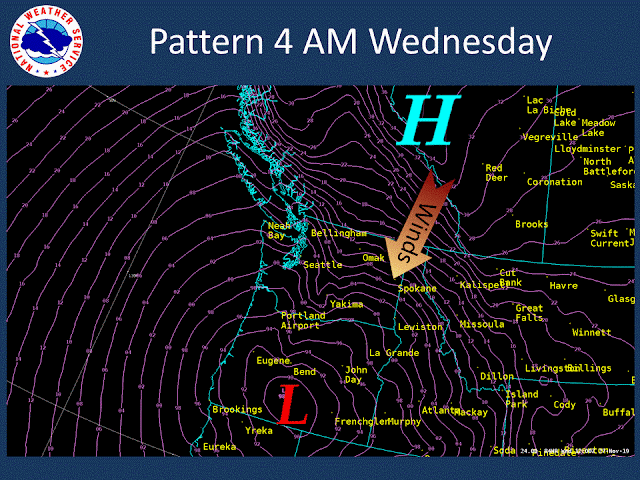Here is an early look at potential wind gusts Wednesday as of our Sunday morning forecast.
 |
| NWS forecast issued Sunday morning - Peak wind gusts Wednesday, November 27th, 2019 |
And with these winds we could see some impacts across the region.
Thanksgiving Eve is one of the busiest travel days of the year. Depending on which roads you're traveling you may experience strong tailwinds, headwinds, crosswinds, or a combination of all. Please monitor the latest forecasts and travel safe.
This is an interesting storm. The maps that follow are forecast maps of Mean Sea Level Pressure (MSLP). The two most important things to know when looking at these maps are
1) Winds blow from high pressure (H) to low pressure (L)
2) The closer the lines are too each other the stronger the wind.
Let's begin with 4 AM Tuesday.
 |
| 00z GFS forecast of MSLP valid 4 AM PST Tuesday, November 26th, 2019 |
A weak low off the northern Oregon coast. Note the large spacing of the pressure lines (pink) over Washington and north Idaho meaning weak winds. Nothing of much interest yet.
 |
| 00z GFS forecast of MSLP valid 4 PM PST Tuesday, November 26th, 2019 |
Whoa! The storm has intensified greatly in just 12 hours from 1006 mb to around 973 mb. Note the northeast winds beginning to increase over our region as pressure gradients begin to tighten with the approaching storm.
 |
| 00z GFS forecast of MSLP valid 4 AM PST Wednesday, November 27th, 2019 |
Wednesday is when winds increase even further. Thankfully, the storm over Oregon weakens, but the squeeze is on between high pressure to our north, and the Oregon storm to our south. Note the tight packing of the pressure gradient. The graphic above was from one model solution (GFS). Other model solutions such as the European and Canadian show a similar depiction.
With the strong northeast winds will come colder air, here are the forecast highs for Thanksgiving Day.
 |
| NWS Forecast issued Sunday morning of high temperatures Thanksgiving Day |
 |
| CPC 6-10 day temperature outlook issued Nov 23rd valid Nov 29-Dec 3rd, 2019 |
 |
| CPC 8-14 day temperature outlook issued Nov 23rd valid Dec 1st-7th, 2019 |
Although currently the cold pattern looks like a dry one with latest CPC 6-10 outlook favoring drier than normal.
 |
| CPC 6-10 day precipitation outlook issued Nov 23rd valid Nov 29-Dec 3rd, 2019 |
But let's not forget what's bringing us the colder weather. And that is strong northeast winds on Wednesday. Those with Thanksgiving Eve travel plans should monitor the latest forecasts. And if you are traveling to other states especially south or east, snow could impact your travel. For the latest forecasts, watches, warnings, and advisories visit weather.gov or for local travel plans across Central and Eastern Washington and north Idaho weather.gov/spokane









